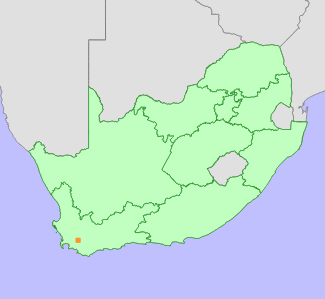|
Scientific Name | Aspalathus singuliflora R.Dahlgren |
Higher Classification | Dicotyledons |
Family | FABACEAE |
National Status |
Status and Criteria | Critically Endangered B1ab(iii)+2ab(iii) |
Assessment Date | 2011/06/19 |
Assessor(s) | L. von Staden, C.H. Stirton & V. Zikishe |
Justification | Alluvial soils around Smousbos Hill, where this species was last collected in 1920, are all cultivated and it was thought to be extinct. However, in 2010 a small population was discovered on a small fragment of Breede Alluvial Renosterveld on a farm in the Brandvlei area near Worcester. The site is degraded and too irregularly burnt, and possibly threatened by further habitat loss to crop cultivation. |
Distribution |
Endemism | South African endemic |
Provincial distribution | Western Cape |
Range | Upper Breede River Valley around Worcester. |
Habitat and Ecology |
Major system | Terrestrial |
Major habitats | Breede Alluvium Renosterveld |
Description | Lowland fynbos on sandy alluvial soils. |
Threats |
| The type locality, the only collection this species was previously known from, is transformed for crop cultivation. Similar alluvial habitats in the Breede River Valley are extensively cultivated. The only extant locality is on a very small fragment surrounded by crop fields. This small population is threatened by a lack of fire, habitat degradation and possibly further habitat loss to crop cultivation. |
Population |
The only known extant subpopulation is confined to a small fragment of less than two hectares. The subpopulation is very small at present, but this may be due to a lack of fire — most Aspalathus species are very abundant in recently burnt vegetation but will decrease as the vegetation matures.
|
Population trend | Decreasing |
Assessment History |
Taxon assessed |
Status and Criteria |
Citation/Red List version | | Aspalathus singuliflora R.Dahlgren | Critically Endangered (Possibly Extinct) | Raimondo et al. (2009) | | Aspalathus singuliflora R.Dahlgren | Indeterminate | Hilton-Taylor (1996) | |
Bibliography |
Dahlgren, R. 1963. Studies on Aspalathus and some related genera in South Africa. Opera Botanica 9(1):1-301.
Dahlgren, R. 1988. Crotalarieae (Aspalathus). In: O.A. Leistner (ed). Flora of southern Africa 16 Fabaceae, Part 3 Papilionoideae, Fascicle 6:1-430. National Botanical Institute, Pretoria.
Goldblatt, P. and Manning, J.C. 2000. Cape Plants: A conspectus of the Cape Flora of South Africa. Strelitzia 9. National Botanical Institute, Cape Town.
Hilton-Taylor, C. 1996. Red data list of southern African plants. Strelitzia 4. South African National Botanical Institute, Pretoria.
Raimondo, D., von Staden, L., Foden, W., Victor, J.E., Helme, N.A., Turner, R.C., Kamundi, D.A. and Manyama, P.A. 2009. Red List of South African Plants. Strelitzia 25. South African National Biodiversity Institute, Pretoria.
|
Citation |
| von Staden, L., Stirton, C.H. & Zikishe, V. 2011. Aspalathus singuliflora R.Dahlgren. National Assessment: Red List of South African Plants version 2024.1. Accessed on 2025/10/26 |
 Comment on this assessment
Comment on this assessment


